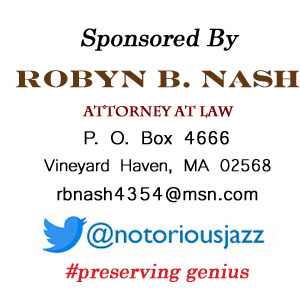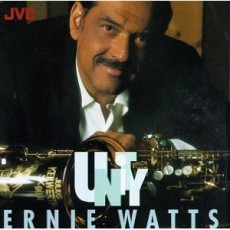
Daily Dose Of Jazz…
Ernie Watts was born Ernest James Watts on October 23, 1945 in Norfolk, Virginia. He began playing saxophone at thirteen, attended West Chester University and later matriculated through Berklee College of Music on a Downbeat scholarship. He toured with Buddy Rich in the mid-1960s, occupying one of the alto saxophone chairs along with Lou Marini.
Watts visited Africa on a US State Department tour with Oliver Nelson’s group, played tenor saxophone with the Tonight Show Band under Doc Severinsen for twenty years and was a featured soloist on many of Marvin Gaye’s original Motown albums during the 1970s. A first-call musician he has sat in on many other pop and R&B sessions during 25 years in the studios in Los Angeles.
By the mid-1980s Ernie decided to rededicate himself to jazz, recording and touring with German guitarist and composer Torsten de Winkel, drummer Steve Smith and keyboardist Tom Coster. He would join bassist Charlie Haden’s Quartet West, play saxophone on the Grease soundtrack, clarinet on The Color Purple and sax on the opening theme song of the popular 80s sitcom Night Court.
Watts has won two Grammy Awards as an instrumentalist, toured with the Rolling Stones, appeared in the 1982 film Let’s Spend The Night Together, was featured on Kurt Elling’s 2010 Grammy-winning album Dedicated To You, formed his own label Flying Dutchman Records, and tours Europe with his quartet.
With flute added to his instrument list, saxophonist Ernie Watts has released eighteen albums as a leader and nearly three dozen as a sideman working with Billy and Bobby Alessi, Paul Anka, Wilie Bobo, Brass Fever, Kenny Burrell, Donald Byrd, Stanley Clarke, Billy Cobham, Randy Crawford, Dizzy Gillespie, Bobby Hutcherson, Milt Jackson, Carol King, John Mayall, Blue Mitchell, New Stories, Lalo Schifrin and Gabor Szabo among others. He continues to perform record and tour.
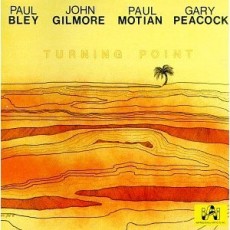
Daily Dose Of Jazz…
John Gilmore was born on September 28, 1931 and grew up in Chicago, Illinois but didn’t start playing the clarinet until age 14. While in the Air Force in the late Forties he took up the saxophone, then pursued a musical career, playing briefly with pianist Earl Hines before encountering Sun Ra in 1953.
For the next four decades, Gilmore recorded and performed almost exclusively with Sun Ra. Thought to have the makings of stardom like Rollins or Coltrane, the latter taking informal lessons from Gilmore in the late 50s and partially inspired by his sound on “Chasin’ The Trane”.
By 1957 he was co-leading a Blue Note date with Clifford Jordan titled Blowing In From Chicago, that is regarded as a hard bop classic with Horace Silver, Curley Russell and Art Blakey. In the mid-1960s John toured with the Jazz Messengers, participated in recording sessions with Paul Bley, Andrew Hill, Pete LaRoca, McCoy Tyner and a handful of others. In 1970 he co-led a recording with Jamaican trumpeter Dizzy Reece, however his main focus throughout remained with the Sun Ra Arkestra.
Gilmore was devoted to Sun Ra’s use of harmony, which he considered both unique and a logical extension of bebop. He was the Arkestra’s leading sideman and soloist, performing with fluency and tone on straight-ahead post bop sessions and abstractly capable of long passages based exclusively on high-register squeals. Though his fame was shrouded in the relative anonymity as a member of Sun Ra’s Arkestra, he led the band after Ra’s death up until his own passing of emphysema in 1995.
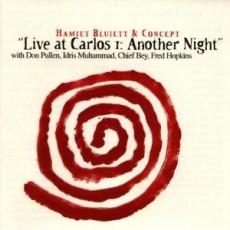
Daily Dose Of Jazz…
Hamiet Bluiett was born on September 16, 1940 in Brooklyn a.k.a. Lovejoy, Illinois, that was founded as a free black refuge community in the 1830s. As a child, he studied piano, trumpet, and clarinet, but was attracted most strongly to the baritone saxophone from the age of ten. He began his musical career by playing the clarinet for barrelhouse dances in Brooklyn, Illinois, before joining the Navy band in 1961. He attended Southern Illinois University Carbondale.
Following his time in the Navy, he returned to the St. Louis area in the mid-1960s. In the late 1960s Bluiett co-founded the Black Artists’ Group (BAG) in St. Louis, Missouri, comprised of a collective dedicated to fostering creative work in theater, visual arts, dance, poetry, film, and music. He led the BAG big band during 1968 and 1969.
Bluiett moved to New York City in 1969 and joined the Charles Mingus Quintet and the Sam Rivers large ensemble. In 1976 he co-founded the World Saxophone Quartet with two other BAG members, Julius Hemphill and Oliver Lake. The group would quickly become jazz music’s most renowned saxophone quartet. He has remained a champion of the somewhat unwieldy baritone saxophone, organizing large groups of baritone saxophones.
In the 1980s, he also founded The Clarinet Family, a group of eight clarinetists playing clarinets of various sizes ranging from E-flat soprano to contrabass. Since the 1990s he has led a virtuosic quartet, the Bluiett Baritone Nation, made up entirely of baritone saxophones, with drum set accompaniment. His return to his hometown in 2002 affords him the opportunity to gig, perform with students from Neighborhood Music School in New Haven, Connecticut under the name of “Hamiet Bluiett and the Improvisational Youth Orchestra”. He has recorded over three-dozen albums and continues to perform, record and tour.

Daily Dose Of Jazz…
Leonard Geoffrey Feather was born on September 13, 1914 in London, England and learned to play the piano and clarinet without formal training and started writing about jazz and film by his late teens. At age of twenty-one, Feather made his first visit to the United States and after working in the U.K. and the U.S. as a record producer finally settled in New York City in 1939, where he lived until moving to Los Angeles, California in 1960.
His compositions have been widely recorded, including “Evil Gal Blues” and “Blowtop Blues” by Dinah Washington, and what is possibly his biggest hit, “How Blue Can You Get?” by blues artists Louis Jordan and B. B. King, and some of his own recordings as a bandleader are still available. But it was as a journalist, critic, historian, and campaigner that he made his biggest mark as one of the most widely read and most influential writer on jazz, and having written the liner notes for hundreds of jazz albums.
Leonard wrote the lyrics to the Benny Golson jazz composition “Whisper Not” which was then recorded by Ella Fitzgerald on her 1966 Verve release of the same name. He was co-editor of the Metronome Magazine and served as the chief jazz critic for the Los Angeles Times until his death on September 22, 1994 in Sherman Oaks, California at age eighty.
He leaves a legacy of a talented daughter, vocalist Lorraine Feather, a couple of dozen albums and several books such as The Encyclopedia Yearbook of Jazz in the Sixties, Inside Jazz and From Satchmo to Miles among others.
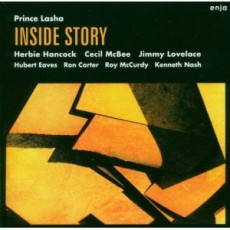
Daily Dose Of Jazz…
Prince Lasha (pronounced “La-shay“) was born William B. Lawsha on September 10, 1929 in Fort Worth, Texas. He came of age studying and performing alongside fellow I.M. Terrell High School students John Carter, Ornette Coleman, King Curtis, Charles Moffett and Dewey Redman.
Lasha moved to California during the 1950s. In the 1960s, Prince Lasha was active in the burgeoning free jazz movement, of which his Fort Worth cohort Ornette Coleman was a pioneer. Lasha worked closely with saxophonist Sonny Simmons, with whom he recorded two albums, The Cry and Firebirds no the Contemporary label, the latter receiving five stars and an AMG Albumpick at Allmusic.
Lasha worked as a sideman appearing on recordings with Eric Dolphy, Elvin Jones/Jimmy Garrison Sextet featuring McCoy Tyner, and with Michael White. In the 1970s, Lasha and Simmons made additional recordings under the name Firebirds. In 2005, Lasha recorded the album The Mystery of Prince Lasha with the Odean Pope Trio.
Saxophonist, flautist and clarinetist Prince Lasha died on December 12, 2008, in Oakland, California. He left a small legacy of six recordings as a leader marking his place in jazz history.





